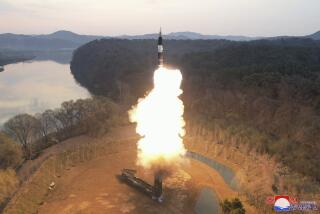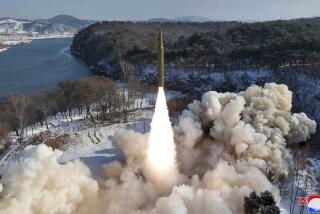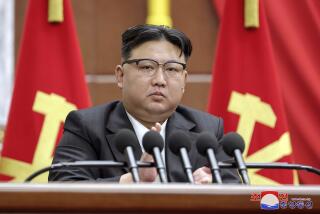U.S. says North Korea’s ICBM launch is ‘a new escalation of the threat to the United States’ and the world

Kim Jong Un vowed North Korea would develop an intercontinental ballistic missile that could reach the U.S.
Six months ago, North Korea’s dynastic leader, Kim Jong Un, announced in clear terms his nation’s resolve to develop a ballistic missile capable of reaching the continental United States.
Such an accomplishment would surely shift the power dynamic in Northeast Asia — and help cement the government’s long-sought status as a nuclear state.
It appears Kim has gotten his wish.
North Korea announced Tuesday that it had, at long last, test-launched an intercontinental ballistic missile — a “glistening miracle,” as state news described it.
Secretary of State Rex Tillerson condemned what he acknowledged was an ICBM test, saying the launch represents “a new escalation of the threat to the United States, our allies and partners, the region and the world.”
The news means an already intractable problem posed by Pyongyang’s advancing nuclear and missile programs just became more difficult for the United States and its regional allies.
“It’s really, really significant from a technological and political standpoint,” said Melissa Hanham, a senior research associate at the James Martin Center for Nonproliferation Studies in California who studies North Korea’s missile program.
A report in North Korean state media on Wednesday said a smiling Kim, speaking to his scientists, referred to the “package of gifts” they had delivered on the U.S. Independence Day, and urged them to “frequently send big and small ‘gift packages’ to the Yankees,” according to the Associated Press.
The report said Kim “stressed that the protracted showdown with the U.S. imperialists has reached its final phase and it is the time for [North Korea] to demonstrate its mettle to the U.S., which is testing its will in defiance of its warning.”
American and South Korean officials, while confirming the launch and expressing concern, said in their initial assessments that the missile appeared to be somewhat less capable than North Korea announced.
Tillerson called upon all nations to publicly stand together against North Korea’s pursuit of nuclear weapons — as diplomats from the United States,
“Global action is required to stop a global threat,” Tillerson said in a statement. “Any country that hosts North Korean guest workers, provides any economic or military benefits, or fails to fully implement U.N. Security Council resolutions is aiding and abetting a dangerous regime.”
U.S. Ambassador to the United Nations Nikki Haley and her counterparts from Japan and South Korea called for a Security Council meeting Wednesday.
“As we, along with others, have made clear: We will never accept a nuclear-armed North Korea,” Tillerson said.
The U.S. Army and South Korea military conducted a combined missile exercise Tuesday as a show of force in response to North Korea’s test.
Multiple Hyunmoo-2 missiles, capable of striking any target in North Korea, were blasted from launchers along South Korea’s eastern coastline into the South’s territorial waters. The exercise took place within 10 miles of the demilitarized zone separating North and South.
“The deep strike precision capability enables the [South Korean]-U.S. alliance to engage the full array of time critical targets under all weather conditions,” the U.S. Army said in a statement.
The apparently successful test wasn’t a surprise for security analysts and military officials like Hanham, who were watching in the fall when North Korea suffered two mysterious and explosive missile failures at the same launch facility.
North Korea has also recently released images from rocket engine tests and displayed what appeared to be several intercontinental ballistic missiles at a massive military parade in Pyongyang this spring. The government has accelerated the pace of its missile testing program in recent years under Kim, a grandson of Kim Il Sung, the nation’s late communist patriarch.
But the new capability — a clear violation of Security Council resolutions — seems to have crossed a psychological threshold. It already has led to widespread alarm that other, shorter-range ballistic missile tests this year haven’t provoked.
“Politically, it’s a game changer,” said Go Myong-hyun, a research fellow at the Asan Institute for Policy Studies in Seoul.
Tuesday’s test, conducted about 9:40 a.m. from Banghyon airfield near the northwestern town of Kusong, was North Korea’s 12th and most significant launch this year.
North Korean media released images of a smiling Kim, who reportedly watched the test nearby on a panel of computer monitors. Other images showed the leader surrounded by celebrating military commanders.
The device, which North Korea called the Hwasong-14, flew on a trajectory more than 1,700 miles into the atmosphere — farther than the International Space Station — for about 40 minutes. It landed more than 500 miles east, in the Sea of Japan, which Koreans call the East Sea.
In theory, the missile’s range could have allowed it to reach Alaska on a flatter trajectory, though such a flight path would have introduced other technical complexities and physical hurdles for the North’s scientists.
Still, it’s a significant accomplishment for the government. “When I heard it was a 40-minute flight,” Hanham said, “my stomach just dropped.”
Newly elected South Korean President Moon Jae-in, who recently discussed North Korea at a summit with President Trump in Washington, convened an emergency security meeting. He also called on the international community to “take action.”
But for South Korea and the United States, which has 28,000 troops on the Korean peninsula, a list of bad options for slowing or stopping North Korea now appears even more limited.
Pyongyang’s nuclear and missile programs have perplexed the last three American presidents. They have tried negotiation, economic aid, international sanctions, diplomatic pressure and even covert action.
The strategies have failed. Experts now believe North Korea is an established nuclear state with more than a dozen devices. A key question had been whether the government could deliver its weapons globally.
Experts believe North Korea needs more time to miniaturize its warheads so that they can be launched on missiles. And scientists there still would need to figure out how to get the warheads to safely and accurately reenter the atmosphere en route to a target.
Still, the aim of long-range delivery now appears within sight despite Trump’s pre-inauguration tweet in January vowing, “It won’t happen!”
The Trump administration has announced a new policy of imposing “maximum pressure” on North Korea, calling for sanctions but also dialogue if the regime ends its program. The administration has left open the possibility of a military strike, but that could prove catastrophic.
North Korea, for example, could retaliate with its masses of conventional weapons, such as artillery, along the border that is about 40 miles from Seoul, a metropolitan area of more than 20 million residents.
Some believe the United States and other countries that have concerns about North Korea’s nuclear and missile programs should negotiate a freeze on testing and perhaps a return of international inspectors to North Korean laboratories.
With all the focus on missiles lately, it’s easy to forget that the North could perform its sixth underground nuclear detonation test any day — another provocation that would further increase the sense of crisis in the region, said John Delury, a North Korea expert at Yonsei University in Seoul.
“There are some diplomatic options — they’re not great — but they’re probably what we should do,” he said.
Trump had hoped that China — North Korea’s only significant trading partner — would help solve the problem. But in recent weeks his administration has grown frustrated with what it claims is a lack of pressure by Beijing on Pyongyang, concerns Trump reportedly expressed in a phone call with Chinese President Xi Jinping this week.
“Perhaps China will put a heavy move on North Korea and end this nonsense once and for all!” Trump tweeted after the launch.
Chinese Foreign Ministry spokesman Geng Shuang insisted China has already made “relentless efforts” to stem North Korea’s nuclear ambitions. And he repeated China’s usual refrain, calling for a stop to actions that violate United Nations resolutions but emphasizing a need for calm and restraint.
Some question whether there’s much more that can be done by China, which also fears that a leadership change in Pyongyang could lead to a North Korean refugee crisis or even a unified Korea that counts the United States as an ally.
“Even if you cancel most of the trade between China and North Korea, I think Kim Jong Un would still be determined to do these nuclear activities,” said Shi Yinhong, an international relations professor at People’s University in Beijing. “I think the problem from China’s perspective is quite serious. And the issue is that China still can’t find a way out of this predicament.”
China announced in February that it would ban North Korean coal imports for the rest of 2017, in line with United Nations sanctions. Yet visitors to the China-North Korea border have witnessed coal trucks crossing, casting doubt on the ban’s efficacy, and China’s trade with North Korea grew nearly 40% in the first quarter of the year, according to Chinese official figures.
North Korea announced Tuesday’s launch on state television, using a familiar news anchor seen in other major announcements, a middle-aged woman in a pink hanbok, the traditional Korean dress.
“The success of the last stage of becoming a nuclear power state is developing an intercontinental ballistic missile,” she read in a booming cadence familiar to North Korea watchers.
Her report added that the test shows the “unwithering power of our state, our strong independence and defense in the world, and will be marked as a significant mark in our history.”
The announcement came after a nearly 30-minute montage featuring soaring socialist songs and patriotic imagery, including panoramas of the Pyongyang skyline and Mt. Paektu, a volcano included in the country’s national emblem.
The montage also briefly included a soaring missile, which perhaps has now given North Korea an advantage it might retain for some time.
“At this point, it’s no longer about denuclearizing the Korean peninsula,” Hanham said. “Now it’s just about containing North Korea as best we can.”
Special correspondent Stiles reported from Seoul and Times staff writer Kaiman from Beijing. Special correspondent Jessica Meyers contributed from Beijing and Times staff writer W.J. Hennigan from Washington.
For more news from Asia, follow @JRKaiman on Twitter
ALSO
After a bloody month in Afghanistan, demonstrators demand security reforms
Volatile Persian Gulf crisis over Qatar tries, divides Trump administration
Bedouins in the West Bank hold fast to their land — as pressure builds for them to leave
President Trump delivers tough trade talk during visit by South Korea’s new leader
U.S. blacklists Chinese bank, revving up pressure over North Korea
UPDATES:
8:05 p.m.: This article has been updated with Kim Jong Un’s remarks.
5:25 p.m.: This article was updated with comments from the secretary of State, U.S. ambassador to the United Nations, U.S. Army and South Korea military.
This article was originally published at 7:45 a.m.
More to Read
Start your day right
Sign up for Essential California for news, features and recommendations from the L.A. Times and beyond in your inbox six days a week.
You may occasionally receive promotional content from the Los Angeles Times.






